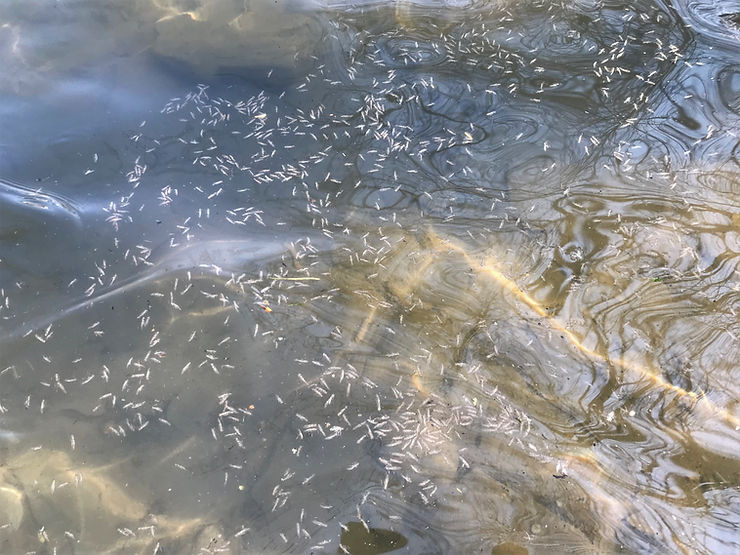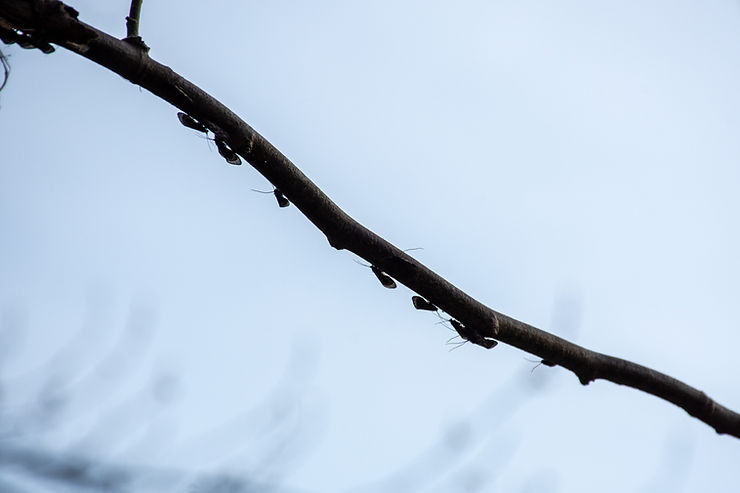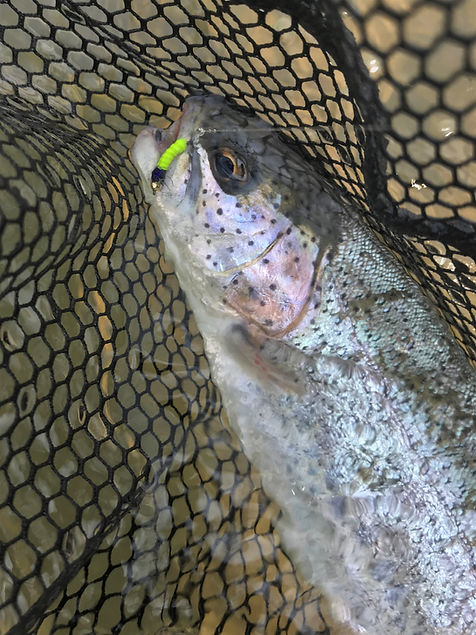The April Caddis: Fishing and Tying Grannoms

Clouds of Grannoms filled the morning air. They came out of the water in waves, one huge flurry after another. There were so many Grannoms that they bounced off of my face, got caught in my net, and a few even flew into my short sleeves and crawled around inside my shirt. Yes, there were that many bugs, which in most cases would be a fly fisherman’s dream scenario, except that this event begged the question: with so many insects in the air and on the water, why did the fishing suck?
I have mixed feelings about Grannoms, or any caddis for that matter. How the fish react to these hatches can be fickle (most of the time), emphatic (some of the time), or frustrating (all of the time) depending on any number of variables. Water temperature, air temperature, abundance of insects – all of these and many others factor into whether a caddis hatch will spur consistent surface feeding.
Grannoms can be the most puzzling of all because they can occur in such massive numbers. With that many insects available, you’d think at least a few trout would key in on them.
Truth is, the trout are keying in on them, just not in the way we fly folks would prefer. While hundreds of thousands of bugs might fill the air, trout often gorge themselves on the many helpless pupa that are much easier targets. And to this point, trout can become so selective as to ignore just about everything that doesn’t look similar to the natural.
Cased Caddis
Brachycentrus, a.k.a. Grannom, is the most common genus of caddisfly found in streams and rivers. Shortly after the egg hatches, it wraps itself in a tubular case made of silk secreted from salivary glands near the mouth of the larva. Once complete, various materials from the substrate, such as rocks, grains of sands, bark, sticks, etc, are attached to the silken case in a systematic pattern. In fact, you can identify a particular family or genus of caddisfly larvae based simply on how these materials are placed on the case.
In his book Caddisflies, Gary LaFontaine describes how the Grannom rappels from one rock to another as it moves about the streambed. They basically attach a thin line of silk to a rock and control their downstream movement and speed by lengthening this silk. In essence, they’re hanging in the current by a silk line, making them a perfect target for a feeding trout. And now you can see why fish would prefer this easy meal over traveling all the way to the surface to eat an adult caddis.

Caddis Pupa
The most accurate way to determine the color of a caddis is to open the case and study the actual pupa. Grannom pupae have greenish bodies and are the most prolific caddis species in this region of the country. Also, whereas some caddis species emerge quickly, Grannoms emerge at a much slower rate. After breaking free of their case, Grannom pupae can drift for several feet before beginning their ascent to the surface. Once in the surface film, it can take them up to 30 minutes to emerge as full-fledged adults. And again, during this time, they’re sitting ducks for hungry trout.
Adult Grannoms
Adult Grannoms emerge from fast-moving water and riffles, and based on my experience, they seem to always head upriver. They gravitate to streamside foliage and tree branches, often mating while hanging upside down like tiny bats or clumped together in shaded areas under logs, rock ledges, etc.
The adults have a dark, brownish-colored body when they first emerge. After mating, the females develop an emerald-colored egg sack. At some point in the afternoon or evening, the females return to the water to lay their eggs. Some females simply flop on the surface while others actually dive underwater to deposit the eggs, but afterward, all of them end up spent in the film.

The Caddis Conundrum
One of the problems with caddisflies is that there are either not enough of them present or there are way too many. For the purpose of fly fishing, the most productive caddis hatches fall somewhere in between, with moderate amounts of insects on the water. I believe this is what makes caddis hatches so frustrating. When there are thousands of caddis in the air, you can bet there are twice that amount getting gobbled up by trout before they even have a chance to reach the surface. So when you finally have enough spent adult caddis on the surface is a moot point. The fish are stuffed before they even reach that stage of the life cycle.
This is also why fishing a caddis hatch is almost always better during the early stages, before the hatch hits its peak. This is usually when I can catch rising fish on a traditional Elk Hair Caddis with a dark brown body. The next best opportunity for dry fly action is when the female Grannoms return to the water to lay their eggs in late afternoon or evening. Tying a small green butt near the bend of the hook on the Elk Hair Caddis does a great job of imitating this phase, but the standard brown body will also work fine.
Once Grannom activity really heats up and the hatch begins in earnest, I usually have more success with cased caddis or caddis pupa imitations. My favorite cased caddis pattern is the Green-Assed Walts, which is a peeking caddis pattern that flat-out kills from mid-April through mid-May. Here’s a link to the article and video for how to tie that pattern.
I also tie a cased caddis with a dubbed rabbit fur body with a green or chartreuse collar. And a third pattern option is a pattern tied with a tail of green or chartreuse ultra chenille and a dubbed body. Some people also add a few wraps of partridge around the tail of the fly near the bend of the hook to give it a soft hackle wet fly appearance, and it can be deadly when swung in the current.

A great way to fish the Grannom hatch is with a caddis pupa. I tie my pupae in two different ways. The first is a Simple Caddis, which is a body of dubbed olive rabbit fur with a copper wire rib and dubbed black collar. I like to tie this one on a 1x-short scud/caddis hook with a black nickel bead.
The second was told to me by my good friend Doug DeFanti (he’s my Yoda when it comes to all things fly fishing), and that fly is even easier to tie: a body of wrapped chartreuse vernille ultra chenille and a black dubbed collar (pictured in photo). I tie this one on a standard length scud/caddis hook with a gold bead.
I fish both of these patterns together on a tandem rig, and catch rates are generally split right down the middle between them. Also, I carry each pupa pattern in sizes ranging from 12 to 16. The Peeking Caddis, which is imitating the pupa in its case, is naturally larger, and I carry that one in size 12.
Perhaps the best thing about Grannom patterns is that there’s no wrong way to fish them. You can dead-drift them, swing them, or skitter them on the water’s surface. The main reason is because the naturals themselves go through such a unique and prolonged emerging process. Trout may not always feed on Grannoms on the surface, but you can bet they’re enjoying some other phase of the hatch.
Sign up for the Dark Skies Fly Fishing e-newsletter
It's free, delivered to your inbox approximately three times each month. Your information is always kept private and used for the sole purpose of keeping you up to date on blog posts and specials in the online store.
Sign Up Now